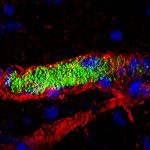Link to Pubmed [PMID] – 22185907
Curr. Opin. Microbiol. 2012 Feb;15(1):50-6
Bacterial infection of human vasculature can lead to unregulated systemic activation of coagulation and innate immunity and rapidly becomes life threatening. Neisseria meningitidis is a vascular pathogen that causes fatal sepsis and meningitis. Post-mortem histological analysis of tissues from individuals infected with N. meningitidis show large bacterial aggregates in close association with the vascular wall of small vessels. The ability of this bacterium to colonize blood vessel endothelium is likely to impact its capacity to both multiply in the blood stream and reach the brain. This process will be referred to as vascular colonization. Recent work has described a number of early steps in N. meningitidis vascular colonization, from attachment to proliferation and dissemination, focusing on the bacterial-host interaction.

